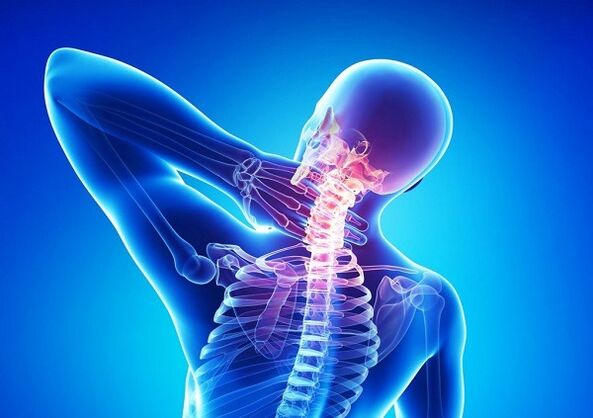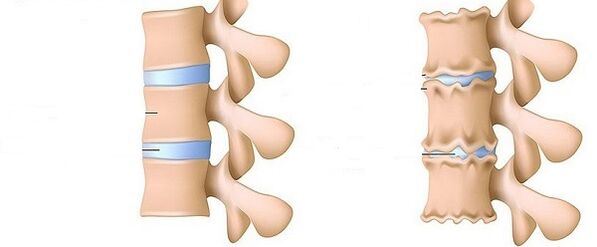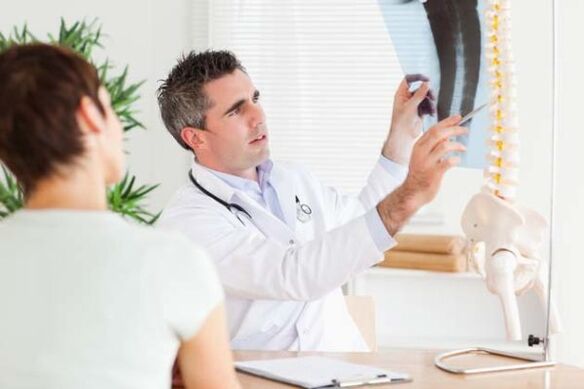Do you often have pain in your neck and head, and the pain radiates to your arm and shoulders? Maybe you have cervical osteochondrosis, which should be treated as soon as possible? How to diagnose the disease and which doctor to consult? And also how to provide first aid for osteochondrosis of the neck? Read more about this and much more later in the article.
Characteristics of the disease
To begin with, let us remember what kind of disease it is. Thus, osteochondrosis of the cervical spine is a disease of the intervertebral discs of the cervical spine, which are the most mobile. In most cases, the lesion occurs at the level of the C5 - C7 vertebrae. The symptoms of the disease also depend on which spine is affected. More on that later.

Reasons for occurrence
To understand how to treat cervical osteochondrosis, you must first understand what causes its appearance. To begin with, let's say that this disease has become more common lately. The age risk zone is from 25 to 40 years. The reasons for the disease can be many. The most common are:
- computer work, as well as frequent and prolonged driving;
- inactivity;
- accumulation of salt in the cervical spine;
- impaired metabolism;
- poor nutrition;
- neck injuries;
- rheumatism;
- heredity;
- hormonal disorders;
- severe hypothermia, etc.

Symptoms
The disease has a number of symptoms that can manifest both together and separately. It all depends on the affected neck area. So, to know how to treat osteochondrosis of the cervical spine, you need to find out what is affected and what the consequences may be. First, consider the general signs of cervical osteochondrosis.
- Pain. Pain syndrome is observed on the neck, nape of the neck, shoulders. Also, pain can be given to the hand. This disease is responsible for 30% of all headaches. All due to the fact that in osteochondrosis, blood vessels can constrict. Thus, the blood flow in the brain is reduced and severe headaches appear, followed by rapid fatigue.
- Crunching. When turning the head and tilting, a characteristic strong crunch is felt.
- Numbness. It can occur in the area of the shoulder blades, accompanied by a strong "lumbago". Also, the neck itself may become numb, while unpleasant tingling will be noticeable in the area of the arms and legs.
- Weakness and dizziness. In addition to all this, frequent fainting, drowsiness, and generally rapid fatigue may occur.

If the treatment of osteochondrosis of the cervical spine will be carried out at home, then you still need to know how to accurately determine the area of the lesion. Here you just need to know what the symptoms will be if one or the other nerve root near the vertebra is affected. There are a total of 8 such processes in the cervical spine, and they are labeled C1 - C8.
- C1 - its defeat shows a loss of sensitivity in the occipital region.
- C2 - there is pain in the back of the head and scalp.
- C3 - the violation was accompanied by severe pain in the area where it occurred. The sensitivity of the neck decreases. The sensitivity of the tongue to taste is weakened. Speech problems may occur.
- C4 - pain in the liver and heart. There is also numbness and pain in the shoulders and between the shoulder blades.
- C5 - pain and decreased sensitivity in the upper shoulder.
- C6 - The area including the neck and shoulder blades is very painful. The pain spreads to the shoulder and radiates to the arm reaching the thumb of the hand.
- C7 - Symptoms are similar to C6, but the pain spreads to the back of the shoulder and to the entire arm, affecting the remaining fingers except the little finger.
- C8 - similar to C7. In addition, numbness and pain had already reached the little finger.
Types
Wondering if it is possible to cure osteochondrosis of the cervical spine at home? Then you need to find out what stage of the disease you have. After all, only the first stage of treatment can be carried out at home. A total of 3 degrees of disease can be distinguished based on its progression.
- The first - it goes on almost imperceptibly and you don’t even start thinking about how to deal with cervical osteochondrosis. But at this stage it is possible to prevent the development of the disease. Symptoms include intermittent numbness of the neck and the area between the shoulder blades during prolonged sitting. Pain is rare, but may be accompanied by stiffness, and fatigue increases.
- The second type is disease progression. The intervertebral discs have shrunk and deformed, but can still be repaired. Every movement of the neck feels crunchy and painful, while the movements are limited. Requires emergency medical attention.
- The third type is the advanced stage of the disease. Here, the integrity of the disks is already compromised. Pains in the neck, head, shoulders are almost constant. Painful sensations are given even to the hands, all the way to the fingers. A disease such as a hernia is possible. With further deformities and improper fusion of the vertebrae, the fight against the disease can be continued only by surgical methods.
Where to seek help?
So, you have some signs of illness and you have decided not to sit back, but to turn to a specialist for help. The question is, "Which doctor treats cervical osteochondrosis? " Well, it all depends on what stage of the disease you have. Therefore, the treatment of grade 1 ulcers can be done by a specialist in therapeutic gymnastics or a masseur. It also includes alternative medicine, namely such a direction as osteopathy.
Osteochondrosis of the 2nd degree of the cervical spine already requires observation by a doctor in the polyclinic. In this handbook, physiotherapists or reflex therapists can deal with the wound. Also, it will not be superfluous to consult a neurologist. Grade 3 cervical osteochondrosis requires more professional treatment. Here the neurologist should initially deal with the disease because there are quite a few nerve endings in the cervical spine. In advanced cases, the surgeon treats osteochondrosis of the cervical spine together with a neuropathologist.

Diagnosis
Before treating osteochondrosis of the neck, you will need to undergo an examination. The doctor will palpate your neck, perform several manipulations and examine you. Be sure to prescribe an X-ray of the cervical ridge. In addition, a general blood test will be prescribed. For a more detailed understanding of the disease, they can be sent for magnetic resonance imaging or CT.
How is the treatment carried out?
To begin with, let’s answer the question, "Is it possible to cure cervical osteochondrosis? " Yes, it is possible, but to fully deal with the disease is possible only in the early stages. So how to beat cervical osteochondrosis? There are various treatments for this, which are described below.
Medications
Medications are the most effective methods of treating grade 2 and 3 cervical osteochondrosis. A complex treatment is carried out here. So, some medications should relieve the pain that has been bothering you. Other drugs fight inflammation. Third - relieve swelling, fourth drugs restore blood circulation and supply the diseased area with nutrients. All of them can be in the form of tablets, and in the form of injections and injections. With osteochondrosis of the cervical spine, fats will be ineffective.

The entire treatment of cervical osteochondrosis in women and men is divided into 3 phases.
- First, medications should quickly overcome pain, relieve swelling, and have an anti-inflammatory effect.
- In the second stage, each drug should produce a regenerative healing effect.
- The third phase is restorative. These include vitamins, therapeutic gymnastics and massage.
Since you have suffered from osteochondrosis and you have decided to go to the hospital, do not self-medicate and follow all the doctor's instructions.
Physiotherapy
Physiotherapy can answer how to cure osteochondrosis of the cervical spine. The most commonly used methods are:
- magnetotherapy;
- electrotherapy;
- laser treatment;
- UFO;
- balneotherapy others.
Surgical intervention
Sometimes only a surgeon can answer how to get rid of cervical osteochondrosis. The operation was scheduled after consultation with a neurologist. Here the surgeon should try as much as possible to get the osteochondrosis that has struck you back. After the operation, prepare for a long recovery course.
ethnoscience
And what will folk medicine say about all this? There are enough methods and means to treat such a disease. However, keep in mind that you are acting at your own risk and responsibility, so only you are responsible for the consequences. So, how to deal with osteochondrosis using folk remedies.
- The first method is compresses for cervical osteochondrosis from Indian onion leaves. To do this, you need to take a leaf of the plant and rub the diseased areas with it, and then put the remains as a compress overnight. The healing effect should be noticed the next morning.
- Another dressing for the night is prepared from cottage cheese sprinkled with vinegar. It is done several nights in a row until the appearance of the treated effect.
- Horseradish leaves are used in a similar way. We take a freshly torn leaf of the plant, wash it in boiling water and apply it to the sore spot overnight, having previously wrapped it in something warm.
- How to cure cervical osteochondrosis with a shovel? And here everything is very simple. The fact is that we do not need the whole shovel, but only the part, which is called the handle longer than a meter. To make a miracle cure out of it, you have to take it with both hands and wrap it around your neck. Next, we massage the diseased areas with up and down movements. The procedure should be done several times a day, for at least a week.

Contraindications to treatment
Sometimes a difficult question is asked, "What can you do with cervical osteochondrosis and what not? " It has been found that not all medical procedures always have only a therapeutic effect. Sometimes they can be very harmful to the patient. Therefore, it is worth treating only with the recommendations of the attending physician. Thus, this includes the following procedures used to treat osteochondrosis:
- acupuncture;
- corrective gymnastics or exercise therapy;
- massage.
Acupuncture for osteochondrosis is contraindicated if you are 75 or older, as well as for pregnant women. Other contraindications for this procedure are identical to massage. This includes:
- Blood diseases.
- Any type of bleeding.
- Increased mental excitability.
- Any difficulty breathing.
- Problems with the digestive system.
Exercise therapy or complex physical therapy, with such a disease as osteochondrosis, also has contraindications. The most common are unhealed injuries, severe bruising, and hematomas. Contraindications are also included here:
- sudden worsening of the disease;
- weak heart;
- manifestation of tachycardia or arrhythmia;
- severe forms of diabetes;
- bleeding tendency;
- infectious ulcers;
- there are diseases associated with the vestibular apparatus;
- you have vision problems;
- neurological symptoms leading to loss of coordination.
How to provide first aid?
If osteochondrosis surprised you at home, then first aid will be as follows:
- Take the painkiller you have at the usual dose.
- Call a doctor at home, as you may need more radical methods and other medications.
- Try not to make sudden movements of the head or body.
- Take the covers off the bed and lie down with a small pillow under your head. If the mattress is soft enough, lie down on a bench or floor.
- Try to relax and think of something good to make the pain reliever work faster. If the doctor is late, do not lie down in one position for a long time.
















